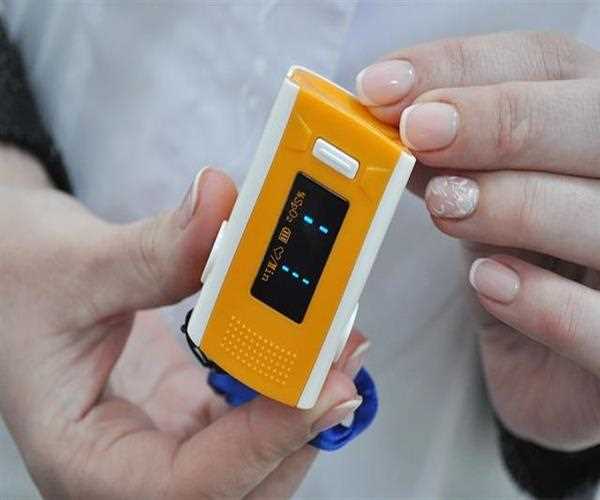Search here

12-Sep-2022
What is the usage of Oximeter?
What is pulse oximetry?
A pulse oximeter test may
be performed on the finger to read blood flow. All systems and
organs in the body need oxygen to survive. Without oxygen, cells
do not function properly and eventually die. Cell death can cause
serious symptoms and eventually lead to organ failure.
The body filters oxygen through the lungs and transports
it to the organs. The lungs then distribute oxygen from the blood
through the hemoglobin protein in the red blood cells.
This protein provides oxygen to the rest of the body. A pulse oximeter measures the
proportion of oxygen in the hemoglobin protein, called
oxy saturation. Oxygen saturation usually indicates how much oxygen is
reaching the organ. Normal oxygen saturation is 95-100%. Oxygen saturation below
90% is considered abnormally low and maybe a clinical emergency.
How does it work?
Oxygen is distributed in red blood cells.
A pulse oximeter is a clip-on device that measures oxygen saturation. The device
can be placed on the finger, wrist, leg, or
anywhere the device can read blood flow.
Oxygen saturation can decrease for several reasons, including:
choke
choke
infections such as pneumonia
drowning
Diseases such as emphysema, lung cancer, and lung infections
inhalation of toxic chemicals
History of heart failure or heart attack
allergic reaction
anesthesia
sleep apnea
Pulse oximeters work by shining light on a relatively transparent area of
the skin. The light hits the sensor on the other side of the
skin.
For example, when you hold a pulse oximeter on your finger, light is
emitted from one side of the clip and detected from the other
side. The amount of light absorbed by the blood indicates its oxygen saturation.
Pulse oximeters do not directly measure oxygen saturation, but
use complex equations and other data to estimate
actual levels.
Benefits of Oximeter
A pulse oximeter is useful for people with conditions that affect oxygen saturation. For example, a sleep specialist
may recommend a pulse oximeter to monitor oxygen saturation
during the night in people with sleep apnea or severe snoring.
Pulse oximeters can also provide feedback on the effectiveness of breathing
measures such as oxygen therapy and ventilators.
Some doctors may use a pulse oximeter to assess the safety of physical activity in people with cardiovascular or respiratory problems or may recommend
wearing a pulse oximeter during exercise. Your doctor may also use
a pulse oximeter as part of a stress test.
Some hospitals use pulse oximeters for particularly vulnerable patients. For
example, a baby in a neonatal intensive care unit may wear
a pulse oximeter that alerts staff to low oxygen
saturation.
Decreased oxygen saturation in infants in neonatal intensive care units
can be detected using a pulse oximeter. A few advantages of pulse
oxygens:
Monitoring oxygen saturation over time
A low level of
oxygen, especially the dangerous warnings of the newborn
Peace for people with chronic breathing or cardiovascular
condition.
Evaluation of additional oxygen requirements
Anesthesia checks the level of oxygen saturation
level
It represents the dangerous side effects
of those using drugs that affect the breathing or saturation
of oxygen.
Pulse infections can be purchased online at present, so they can be used by some people without risk
factors.
Some companies are currently selling pulse oxygens for the parents of
small babies. While these devices promise peace of mind for parents concerned about sudden infant death syndrome (SIDS) and
sleep accidents, there are no studies to support claims that they prevent SIDS or
accidents.
What to expect?
Pulse oximetry devices are non-invasive and do not pose any
danger. Some people experience mild irritation, including redness and
skin sensitivity.
Wearing it too tight and using it for a long time can cause the pulse
oximeter to block oxygen from the surrounding blood vessels.
People with numbness, itching, or discoloration of the skin should
see a doctor immediately.
The main danger of pulse oximetry is incorrect readings. The accuracy of
a pulse oximeter depends on proper installation, and
small changes in position can result in inaccurate
readings. A person knocked over while sleeping can disconnect the
device and set off a false alarm. Oxygen saturation may
decrease in the short term due to changes in sleep status or other
factors such as shortness of breath. A pulse oximeter
warns you even if the fall is temporary and harmless.
For people with health problems or who have not
been helped by doctors to understand the role of
the pulse oximeter, this may be an unnecessary concern.
Conversely, a pulse oximeter can give some people a false sense of security.
It does not provide warnings of all possible oxygen
problems and does not replace any other form of monitoring.
People who use a pulse oximeter should discuss the risks with
their doctor and monitor the readings over time. Changes in
size, especially with environmental changes, sometimes indicate health
problems.
Those interested in using a consumer pulse oximeter should discuss their plans with
their doctor before investing in the device.
Limitations of an Oximeter
Several factors can reduce the accuracy of pulse oximeter readings, including:
momentum change
Carbon monoxide poisoning that pulse oximeters may not
warn about
bilirubin levels
plasma lipids
Ambient light or color interference, including nail polish
If the hands are cold or the blood circulation is poor
Individuals using pulse oximeters to monitor oxygen saturation should not rely on
oximeters as a substitute for subjective
experience.
People who have shortness of breath, shortness of breath, dizziness, or other
symptoms of lack of oxygen should see a doctor.

Student
An inquisitive individual with a great interest in the subjectivity of human experiences, behavior, and the complexity of the human mind. Enthusiased to learn, volunteer, and participate. Always driven by the motive to make a difference in the sphere of mental health - and normalize seeking help through a sensitive and empathetic approach
Join Our Newsletter
Subscribe to our newsletter to receive emails about new views posts, releases and updates.
Copyright 2010 - 2025 MindStick Software Pvt. Ltd. All Rights Reserved Privacy Policy | Terms & Conditions | Cookie Policy